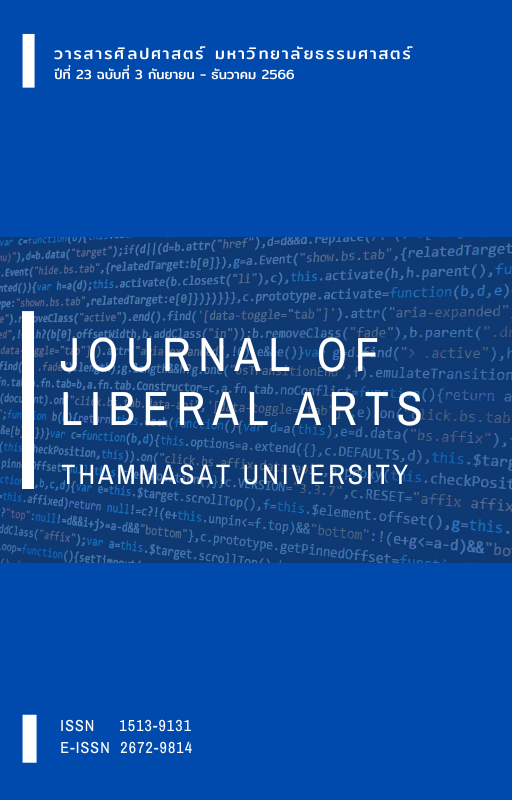Mood, Modality, and Multimodality Analysis in the Thai Government’s Infographics during the Covid-19 Pandemic
Main Article Content
บทคัดย่อ
The purposes of the current study were to explore the interpersonal clause grammar found in mood selections and modality choices and to analyze the multimodality of the Covid-19 infographics published by the Ministry of Public Health of Thailand. The theoretical frameworks were based on Halliday’s Systemic Functional Linguistics (Halliday & Matthiessen, 2014) and modes of communication (Kress, 2010; The New London Group, 1996). The findings suggested that the infographics informed and provided prevention methods for the Covid-19 virus to the general Thai population. The use of obligation and modal markers were significantly higher than other types of modality due to the media’s purpose. The infographics also contained imperative clauses most frequently, followed by declarative clauses, whereas interrogative clauses were not found. In terms of multimodal analysis, the elements and formats in the Covid-19 infographics were similar and interrelated to convey meanings. The consistent presentation helped readers follow the government’s instructions easily.
Downloads
Article Details

อนุญาตภายใต้เงื่อนไข Creative Commons Attribution-NonCommercial-NoDerivatives 4.0 International License.
เอกสารอ้างอิง
Acosta, M. F. (2018). A multimodal discourse analysis of childish Gambino’s music video “This is America”. Open Journal for Studies in Linguistics, 1(2), 57-72. https://doi.org/10.32591/coas.ojsl.0102.04057a
Balkac, M., & Ergun, E. (2018). Role of infographics in healthcare. Chinese medical journal, 131(20), 2514-2517. https://doi.org/10.4103/0366-6999.243569
Butt, D. (2019). Firth and the origins of systemic functional linguistics: Process, pragma, and polysystem. In G. Thompson, W. Bowcher, L. Fontaine, & D. Schönthal (Eds.), The Cambridge Handbook of Systemic Functional Linguistics (pp. 11-34). Cambridge University Press. https://doi.org/10.1017/9781316337936.003
Clark, R. C., & Lyons, C. (2010). Graphics for learning: Proven guidelines for planning, designing and evaluating visuals in training materials. Pfeiffer.
Dajem, A. S., & Alyousef, H. S. (2020). An analysis of mood and modality in workplace discourse and the impact of power differentials: Ramsay’s kitchen nightmares. Advances in Language and Literary Studies, 11(4), 48-61. https://doi.org/10.7575/aiac.alls.v.11n.4p.48
Department of Disease Control. (2020). How to Manage to be Free from the Coronavirus. Department of Disease Control. https://ddc.moph.go.th/viralpneumonia/info.php
Doyle, S. (2017). English 302: Characteristics of Good Government Writing. University of Victoria. https://web.uvic.ca/~sdoyle/E302/Notes/Characteristics.html
Dunlap, J. C., & Lowenthal, P. R. (2016). Getting graphic about infographics: Design lessons learned from popular infographics. Journal of Visual Literacy, 35(1), 42-59. https://doi.org/10.1080/1051144x.2016.1205832
Gill, A. K. (2022). Conformity through fear: A multimodal critical discourse analysis of COVID-19 information adverts. CADAAD Journal, 14(1), 22-44. https://lancaster.ac.uk/fass/journals/cadaad/wp-content/uploads/2022/04/Vol14.1-Art2-GillLennon.pdf
Halliday, M. A. K. (1978). Language as social semiotic: The social interpretation of language and meaning. Edward Arnold.
Halliday, M. A. K. (1994). An introduction to functional grammar. Edward Arnold.
Halliday, M. A. K., & Matthiessen, C. M. I. M. (2014). Halliday’s introduction to functional grammar (4th ed.). Routledge.
Kaur, H., & Kaur, K. R. (2021). Investigating the effects of consistent visual identity on social media. Journal of Indian Business Research, 13(2), 236-252. https://doi.org/10.1108/jibr-06-2020-0174
Kress, G. R. (2010). Multimodality: A social semiotic approach to contemporary communication. Routledge.
Kress, G., & Van Leeuwen, T. (2006). Reading images: The grammar of visual design. Routledge.
Mandelli, A., & Vianello, S. (2010). Channel credibility of the internet as a bundle of different media. SSRN Electronic Journal. https://doi.org/10.2139/ssrn.1687325
Marentette, P., Furman, R., Suvanto, M. E., & Nicoladis, E. (2020). Pantomime (not silent gesture) in multimodal communication: Evidence from children’s narratives. Frontiers in Psychology, 11. https://doi.org/10.3389/fpsyg.2020.575952
Mirbabaie, M., Bunker, D., Stieglitz, S., Marx, J., & Ehnis, C. (2020). Social media in times of crisis: Learning from Hurricane Harvey for the coronavirus disease 2019 pandemic response. Journal of Information Technology, 35(3), 195-213. https://doi.org/10.1177/0268396220929258
Pandya, M. (2021). A comparative visual content analysis of the CDC and WHO COVID-19 infographics [Master’s thesis, Missouri University]. ProQuest.
Patpong, P. (2006). A systemic functional interpretation of Thai grammar: An exploration of Thai narrative discourse [Doctoral dissertation, Macquarie University]. Macquarie University Theses.
Rangkupan, S. (2005). A system of epistemic modality in Thai. Manusya, 8(1), 51-67. https://doi.org/10.1163/26659077-00801004
Sandoval-Almazan, R., & Valle-Cruz, D. (2021). Social media use in government health agencies: The COVID-19 impact. Information Polity, 26(4), 459-475. https://doi.org/10.3233/IP-210326
Smith, D. (2018). Growing your library career with social media. Chandos Publishing.
Syamsidar, S., Yatmikasari, I., & Nurrachman, D. (2019). Mood and modality in Soekarno’s 1955 speech. Paradigm, 2(2), 109-120. https://doi.org/10.18860/prdg.v2i2.7638
Tannen, D. (2007). Talking voices: Repetition, dialogue, and imagery in conversational discourse. Cambridge University Press.
The New London Group. (1996). A pedagogy of multiliteracies: Designing social futures. Harvard Educational Review, 66(1), 60-93. https://doi.org/10.17763/haer.66.1.17370n67v22j160u
Thompson, G. (2000). Introduction Functional Grammar. Foreign Language Teaching and Research Press.
Ure, J. (1989). Text Typology. Manuscript.
Yao, Y., & Zhuo, Y. (2018). A multimodal discourse analysis of the promotional video of Hangzhou. English Language Teaching, 11(10), 121-131. https://doi.org/10.5539/elt.v11n10p121
Yu, H. (2017). Interpersonal meaning of mood and modality in English public service advertising texts. In Proceedings of the 7th International Conference on Education, Management, Information and Mechanical Engineering (EMIM 2017): Advances in Computer Science Research (ACSR), 76, 222-227. Atlantis Press. https://doi.org/10.2991/emim-17.2017.48


